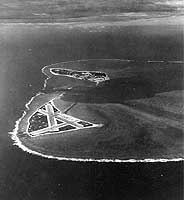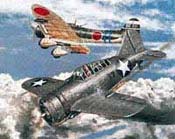The Battle of Midway June 4-7, 1942

There are numerous official and unofficial websites devoted to
the Battle of Midway and the battle which immediately preceded it, the Battle
of the Coral Sea. The Coral Sea Battle was hardly a major victory for the
US navy, but finally, for the first time, navy pilots and aircraft carriers
met the enemy in battle and came out with some success. the following is a summary
of the battle's significance:
On the face of it, the Battle of the Coral Sea appeared to
be a victory for the Japanese. The Imperial Navy had sunk one American fleet
carrier and damaged another, sunk an oiler and a destroyer, while losing only
Shoho and a large number of planes, and suffering severe damage to Shokaku
and enough damage to Zuikaku to keep both out of the war for several months.
It was a tactical victory for the Imperial forces. However, the battle was
a strategic victory for the Americans. The Coral Sea meant the end of Japanese
expansion southward. They would never again threaten Australia and New Zealand.
Here is a brief descrption of the battle, in May 7, 1942, the
following took place:
9:20 A.M.
The Japanese light carrier, Shoho, was bombed and torpedoed from one
end to the other. She was sinking. Six Shoho Zeros were still in the air.
Two American fighters fell, and three of the six Japanese fighters were shot
down, as well as the land- based scout plane that had come to help them.
The Americans were jubilant. An America hard-pressed by a dismal succession
of nightmare stories of surrenders in the Philippines, battles lost, and great
ships sacrificed, was to hear the statement that would thrill a nation. R.E.
Dixon, second in command of Lexington's dive bombers shouted into his microphone,
"Dixon to carrier. Scratch one flattop," referring to the carrier
Shoho. Admirals Fletcher and Fitch, fed information from Nimitz and MacArthur's
intelligence, knew that the main battle had not yet even begun.
9:24 A.M.
Yorktown launched 24 dive bombers, six fighters, and nine torpedo bombers.
Lexington launched a comparable force ten minutes later. The day had formally
begun. The cream of the American crop was meeting the cream of the Japanese
crop. The pilots of Shokaku and Zuikaku were the most experienced
of the war, they had participated in the raid on Pearl Harbor. Each force
found the others mother ships, separated by 175 miles of sea, and delivered
fierce attacks, far out of sight of their commanders.
11:40 A.M.
Yorktown's pilots severely damaged Shokaku. 100 of her crew were dead,
50 wounded. Shokaku was one of Japan's beloved immense carriers. She
and Zuikaku were licking their battle wounds at home during the Battle
of Midway. Had these veteran carriers been present for that decisive battle,
Admiral Yamamoto might have won, changing the entire course of events in the
war of the Pacific.
The Battle of the Coral Sea had taken place completely in and from the air.
Torpedo planes dropped their blasts on enemy carriers while defensive planes
and support ships fired on the enemy. It was the first Naval battle in which
no ship on either side ever sighted the other. It went on all day. American
estimates were conservative. It was believed that one Japanese carrier had
been damaged, but that the Japanese were still ready to battle. The Japanese,
however, believed that they had won. They reported that two American carriers
had definitely been sunk. In the first big carrier battle in the Pacific War
and in all of history, the Japanese had tested their ability against that
of the Americans, and they had prevailed.
The "New York Times" had called the battle a great
American victory, estimating that 17 out of 22 Japanese ships were sunk. Fletcher's
estimate was two destroyers, three cargo ships, four gunboats, one light cruiser,
one light carrier, various gunboats and other small craft, and one light cruiser
that had beached itself. The carrier Zuikaku had been slightly damaged,
as well as one destroyer, another heavy cruiser, and the carrier Shokaku.
Three torpedo bombers off Port Moresby and five sea planes, three patrol bombers,
seven fighters, and fourteen torpedo bombers in the air had all been destroyed.
In all, 144 Japanese planes and 5100 Japanese. Fletcher knew what the American
losses were: one carrier, one destroyer and one tanker sunk, and one carrier
damaged. Fifteen Lexington planes had been lost in combat, and 35 had gone
down with the ship. Sixteen Yorktown planes had been lost in combat. In all,
the Americans had lost 66 planes and an estimated 543 men.
The significance of the Battle of the Coral Sea was that the Americans had
foiled the occupation of Port Moresby and the knockout of Australian air power.
These were necessary before carrier strikes by the Japanese against Australia.
In a few weeks the Americans would land on Guadalcanal, and the Japanese would
eventually be driven out of the Solomon Islands after months of attrition
warfare. There would be no more expansion, bases, or victories for Japan.
Although both forces withdrew simultaneously, the Japanese had two less carriers
for the Battle of Midway, and erroneously believed that the Americans had
lost the Yorktown. Just as important was Admiral Yamamoto's determination
to wipe out the American Fleet in the wake of the Battle of the Coral Sea. The American people must be convinced
that the Japanese could not be defeated. Desperate for victory, the Japanese
were marching down the road of defeat.
On Midway see:
Battle of Midway: Summary
The Battle of Midway was the most decisive single naval battle
in US history. After having so little to show for the efforts until the Battle
of the Coral Sea, Midway was finally a day with significant results for the
US. Four large Japanese carrier's were sunk in one day:
The Akagi, the Kaga, the Soryu and
the Hiryu
Equally important, the Japanese lost 332 planes and experienced
pilots as well.
The US lost one carrier, 1 destroyer and 147 planes.
For Japan, the war was mostly defensive after this. Also, the
battle cost the Japanese the pilots a full year of training. Furthermore, the
Japanese Navy lost the secret of its Zero fighter when one that crashed on the
Aleutians was hauled off to California in quite good condition. There it could
be studied leading to the development of the F6F Hellcat, which would, just
a year later, begin to destroy Japanese air supremacy.
Interestingly, news of this momentous turn of events was not
reported to the Japanese people.
The key to the battle was that the US had broken the Japanese
code and knew that the feint to the Aleutian Islands was just that, a feint.
The US attack force was waiting for the Japanese carrier fleet to assemble for
the attack on Midway. Admiral nagume's forced steamed toward Midway with four
carriers. Admiral Yamamoto's group remained behind waiting to ambush the american
carriers on their way to defend Midway. But the US knew what Japan was up to
though, of course, not the exact location of the enemy ships. They key in these
carrier battles was to locate the enmy carriers by means of scout planes.
The Japanese began their attack on Midway island, but when they
figured out that all the scout planes and attack planes could not be coming
from Midway alone, they relaized the American fleet must be nearby.
The Japanese were torn and when they decided to go after the
American carriers, they were caught in a logistical nightmare. Wanting to follow
up on their earlier attack on Midway, they had armed their bombers with bombs.
Now, however, in the midst of battle, they wanted to refit the bombers with
torpedoes in order to destroy US carriers. Simultaneously, the Zeros defending
the Fleet were returning to their carriers for rearming and refueling. So, at
the time the naval battle was joined, the Japanese carriers were not really
effective warships: they were more like floating arsenals. Bombs were lying
around, and armed and fueled planes were in place for Nagumo's strike against
the enemy fleet. Here is what transpired:
The Kaga:
McCluskey's attack on the Kaga was perfectly executed. While his own
bomb missed, Lt. Gallaher planted his bomb amidst the parked planes on the after
section of the flight deck, setting that entire area on fire. Moments later,
another bomb penetrated the forward elevator, exploded among the planes fueled
and armed on the hangar deck, and shattered the bridge windows, opening them
for bomb number three, which exploded a fuel truck in front of bridge. The succeeding
explosion killed the captain and bridge officers, leaving the ship helmless
for quite some time. The last bomb hit exploded in the hangar, adding to the
carnage. The fires were soon out of control, and by 1700, abandon ship was sounded.
The Akagi:
The Akagi was not hit by as many bombs, but the results
were equally terrifying. The first bomb struck the carrier on the midship elevator,
exploding improperly stored ammunition, dooming the ship. The second and last
bomb struck the planes being rearmed, detonating whatever ammunition was on
them. The aft magazines could not be flooded, and even CO2 could not extinguish
the hangar deck fires. The engines died at 1040, and Admiral Nagumo left his
blazing command at 1046. Abandon ship was sounded at 1900, although few personnel
remained after earlier transfers, and Captain Aoki was removed from the carrier
as, presumably, the last living individual at 0300 on 5 June.
The Soryu:

The Soryu's story was different only so far as her hunters were from
a different carrier. Lt. Cmdr. Maxwell Leslie of Yorktown, leading VB-3, was
somewhat ill-fated during the approach. Leslie quickly chose a large carrier
he identified as Kaga as his unit's target. It was actually the smaller
Soryu but a nice prize nevertheless. The Soryu was struck by three
bombs, neatly placed from fore to aft, exploding near all elevators, destroying
all planes and ammunition stored on and beside the planes, and was out of the
action by 1040, ten minutes after the last Yorktown planes had pulled up. Five
minutes later, abandon ship was sounded, and Captain Yanagimo committed suicide
by plunging into the raging fires. Attempts to keep her afloat were made, but
shortly after 1920, she finally slid into her watery grave.
The Hiryu:

On the US side, the Yortkown was sunk, but Yamaguchi on the Hiryu would
not be able to entertain himself with his success. At 1450, a U.S. scout had
found him, and ten minutes later, Lt. Gallaher from Enterprise set off to bag
his second carrier of the day. Thirteen dive-bombers struck the carrier as her
pilots were eating, while eleven more attacked battleships in the screen --
a foolish maneuver, to split one's bombers and go after such minor targets as
a battleship in the presence of a carrier, but fortunately not resulting in
disaster, for four bombs of Gallaher's group struck in rapid succession, completely
destroying the flight deck, and setting the hangar deck aflame. But no bomb
penetrated deeply. The Hiryu still made 30 knots after the attack. She
was immediately surrounded by ships lending hoses and spraying the ship, whose
firefighting equipment had been destroyed. But the fires were not containable.
They spread below, and exterminated the brave engine crews, stopping the ship.
The crew abandoned the ship starting 0315 on June 5th, but not so Admiral Yamaguchi
and Captain Kaku, who both committed suicide on their ship.





